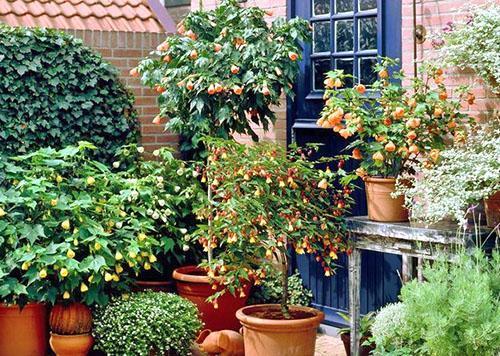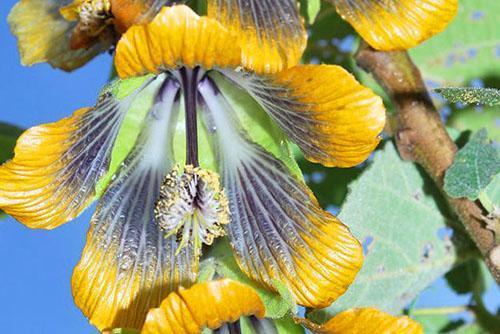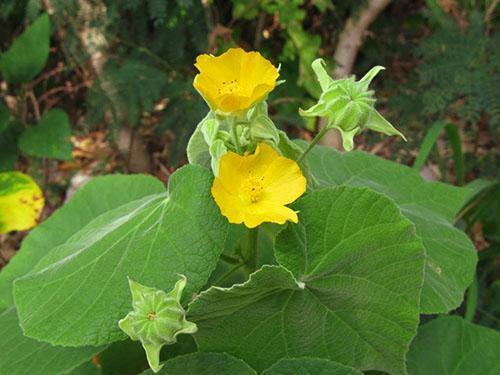Interesting facts about abutilon indoor maple
 At home, in gardens and greenhouses, many species and varieties of abutilon are grown. Plants are distinguished by high growth rate, undemanding and abundant flowering. Due to the shape of the bell-shaped flower, the abutilon flower earned the popular name "Chinese lanterns", and the three- or five-toed leaves of the plant gave it a different name - "indoor maple".
At home, in gardens and greenhouses, many species and varieties of abutilon are grown. Plants are distinguished by high growth rate, undemanding and abundant flowering. Due to the shape of the bell-shaped flower, the abutilon flower earned the popular name "Chinese lanterns", and the three- or five-toed leaves of the plant gave it a different name - "indoor maple".
Indeed, some varieties of abutilone resemble this tree, but in fact, they have nothing in common, except for external similarity. But another popular name, "Indian mallow", can be considered the most accurate.
Indoor maple or abutilon belongs to the extensive mallow family, which, in addition to it, includes hibiscus, itself stock-rose or mallow, cotton and okra.
In search of the homeland of abutilon

In this case, it will not work to give an unambiguous answer by specifying the geographical area or name, since one or another variety of abutilone can be found in the tropics and subtropics of North and South America, Africa, Asia and Australia. At the same time, only a small part of the plants are grown as decorative and potted crops.
And some species, for example, Theophrastus abutilone, is a valuable industrial crop for China. From the dried stems in the homeland of this abutilone species, a strong natural fiber is obtained, traditionally used for the manufacture of ropes, mats, rough fabrics and other goods. Therefore, another name known all over the world, "cable car", abutilon received not without reason.
 The genus received its official name in the 18th century, and the word "abutilon" came to Latin from the Arabic language. Abu-tilun, according to legend, this name was given to the genus by Avicenna, who described the healing properties of local plant varieties.
The genus received its official name in the 18th century, and the word "abutilon" came to Latin from the Arabic language. Abu-tilun, according to legend, this name was given to the genus by Avicenna, who described the healing properties of local plant varieties.
Indoor maple: wild and domestic abutilone
 At home today, hybrid plants are most often grown. They are more compact than their wild relatives, bloom more abundantly and longer, are easier to shape and do not require special care.
At home today, hybrid plants are most often grown. They are more compact than their wild relatives, bloom more abundantly and longer, are easier to shape and do not require special care.
Meanwhile, in nature, many types of indoor maple or abutilon resemble a tree not only in the shape of foliage, but also in size. Varieties from southern China, Australia and Brazil are tall, up to three meters, shrubs, which winter and bloom perfectly in the conditions of the tropics or subtropics native to abutilon. In the middle lane, a thermophilic plant survives only in a greenhouse, winter garden, or in a pot culture.
All representatives of the genus are characterized by the presence of heart-shaped or lobed foliage, covered with a gray, rather hard felt. The peculiarities of the indoor maple abutolon include single or paired flowers that form in the axils of the leaves and delight the grower from early spring to mid-October. Corollas of five petals connected at the base in diameter can reach from 4 to 7 centimeters. And depending on the type and variety of plant, the shape of the flower is bell-shaped or wider, cupped.
Flowers of wild plants are often colored yellow, orange or pink.And modern cultivars and hybrids of indoor maple or abutilon amaze with an abundance of shades, from snow-white to deep burgundy. There are terry varieties today.
Abutilone: is the plant poisonous?
 Many indoor plants from tropical regions of the planet can be potentially dangerous because their tissues contain toxic or corrosive substances.
Many indoor plants from tropical regions of the planet can be potentially dangerous because their tissues contain toxic or corrosive substances.
When planting abutilone or indoor maple, a florist can be absolutely sure that the plant will not cause harm even if children or pets show interest in velvet leaves or bright flowers.
Abutilone is not poisonous and, in addition, has a number of properties useful for humans, used by traditional and official medicine. In the homeland of abutilon, where the plant is widespread and known to people for many centuries, its leaves, barks, flowers and seeds are used in the treatment of a variety of ailments.
For example, in the Philippines, a decoction of wild-growing leaves is used to cleanse wounds and ulcers. This remedy has a soothing and soothing effect, helping to relieve symptoms of fever and colds.
 In the tropics, where people until recently faced the risk of contracting malaria, plant materials from abutilone were used for the preparation of drugs and for this dangerous disease.
In the tropics, where people until recently faced the risk of contracting malaria, plant materials from abutilone were used for the preparation of drugs and for this dangerous disease.
The bark of the indoor maple abutilon is astringent and diuretic, while the seeds and leaves have laxative, anti-inflammatory and expectorant properties.
In China, the foliage of abutilone is heated and then given to tuberculosis patients suffering from urticaria, edema and inflammation of the internal organs. With this broth, long non-healing wounds and ulcers are washed, used for stomatitis and teething in children.
In India, products based on the green parts of abutilone are used for cough and fever, hemorrhoids, diabetes mellitus and diarrhea, furunculosis and purulent skin rashes. Compresses made from crushed flowers and leaves are a folk remedy for burns and wounds on the skin surface. The seeds of abutilon in the homeland of the plant are burned in order to fumigate a child infected with worms with smoke.
 Similar ways of using greens, flowers, bark and roots of abutilone are in other regions of Indochina, which could not but interest scientists. To a greater extent, all the useful properties of the cable car were confirmed.
Similar ways of using greens, flowers, bark and roots of abutilone are in other regions of Indochina, which could not but interest scientists. To a greater extent, all the useful properties of the cable car were confirmed.
Today, some species of wild-growing abutilones have received the status of medicinal plants with analgesic, anthelmintic, astringent, sedative, diuretic, expectorant and laxative effects.
Studies have shown that plant tissues contain substances that can act as immunomodulators, antioxidants and hepatoprotectors. Abutilone can be considered a natural antimicrobial, antimalarial, pain reliever and anti-inflammatory agent.
Abutilon: plant energy
 Unfortunately, the study of the medicinal properties of the plant did not touch the indoor maple, hybrid abutilone, which is a popular domestic crop today. But the beauty of this small shrub already carries a positive charge and is capable of raising the mood of people.
Unfortunately, the study of the medicinal properties of the plant did not touch the indoor maple, hybrid abutilone, which is a popular domestic crop today. But the beauty of this small shrub already carries a positive charge and is capable of raising the mood of people.
The energy of the abutilon plant is so positive that a green pet blooming on the windowsill can relieve stress, dispel sad thoughts and melancholy, direct a person to creative achievements and good deeds.
Experts are sure that non-toxic abutilone can be placed in the children's room without fear for the health of the baby. Such a plant has a place in the living room and in other rooms where all family members gather.
 Abutilon is a plant, the energy of which helps people to find mutual understanding and not feel lonely. Therefore, if in the house or in the office "clouds are gathering and a thunderstorm is outlined," it's time to put a pot of brightly blooming indoor maple in a prominent place.
Abutilon is a plant, the energy of which helps people to find mutual understanding and not feel lonely. Therefore, if in the house or in the office "clouds are gathering and a thunderstorm is outlined," it's time to put a pot of brightly blooming indoor maple in a prominent place.